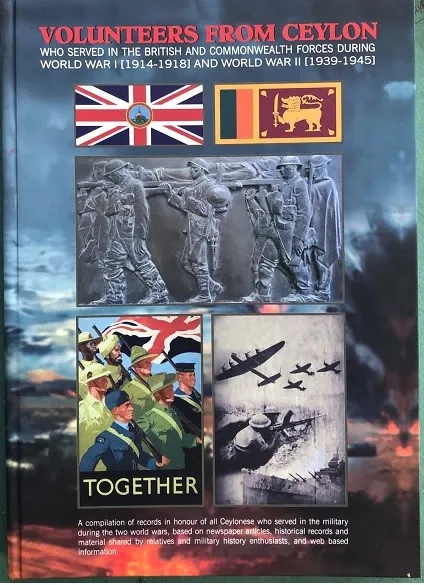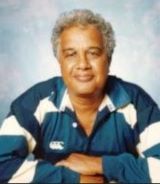Fighting & Dying FOR Britain during the Two World Wars – By Michael Roberts

Source : thuppahis
 A New Book on The Ceylonese Volunteers in World War I and World War II
A New Book on The Ceylonese Volunteers in World War I and World War II
The reasons for printing the book on the Ceylonese Volunteers in WW 1 & 2 were as follows: to record for posterity the sacrifice, dedicated commitment and volunteerism of over 1500 Ceylonese Volunteers in WW 1 and over 6000 Ceylonese Volunteers in WW 2. Many fell in battle, some were injured and many others sacrificed their youth to serve in the British Forces. Their service and sacrifice needs to be recorded with gratitude which is the sole purpose of the book.
It was compiled by a team of retired Tri-Forces officers from available information in the public domain. The book also incorporated over 300 pages of our military history and the formation of the three Armed Forces. The Ceylon Defence Force was the precursor to the present-day Sri Lanka Army and similarly the Ceylon Royal Navy Volunteer Reserve (CRNVR) and the Royal Air Force (RAF) units in Ceylon formed the initial force structure of the present-day Sri Lanka Navy and Sri Lanka Air Force.
Therefore, the team of officers who compiled the records in a chronological order and published the book requests the support and assistance of the public and well-wishers globally to contribute to this worthy cause enabling us to record the military history of Sri Lanka for posterity.
Our immediate aim is to print 2000 copies of the book and raise funds to meet the expenses of printing the book which has been completed with the assistance of the Naval Printing Unit on the directions of the Sri Lanka Navy Commander. Subsequently collect additional funds through contributions/donations to produce two plaques to be placed at the Cenotaph dedicated to all those Ceylonese Volunteers who fought in WW 1 and 2. Finally to educate our youth through the present-day school cadets of the four public schools (Royal, St. Thomas’. Kingswood and Trinity Colleges) who represented the Ceylon contingent that went to WW 1 and fought alongside the British Forces in Europe. Most were 18-year old schoolboys, some young old boys and a few Masters including a Principal of one of the Colleges. These inspirational Principals motivated and led their students to serve their motherland during a crisis situation. Let that spirit and commitment of serving the motherland be perpetuated and spread through the present-day schoolboy cadets as youth volunteers in the development of the Cenotaph. In turn we hope to request the SLESA to permit the laying of four wreaths at this year’s Remembrance Day parade in November.
We sincerely wish that the present-day President, Service Chiefs, the Armed Forces and retired veterans would rally round the call to Honour all Sri Lankans who have served the motherland during a crisis and pay them their due respect as a grateful nation.
We must always remember FREEDOM HAS A PRICE. LEST WE FORGET.
ABSTRACT of the Book Ceylonese Volunteers in WW 1 & 2.
VOLUNTEERS FROM CEYLON WHO SERVED IN THE BRITISH AND COMMONWEALTH FORCES DURING WORLD WAR 1 [1914-1918] AND WORLD WAR 2 [1939-1945]
ABSTRACT
This abstract is a compilation of records in honour of all Ceylonese who served in the military during the two world wars, based on newspaper articles, historical records and material shared by relatives, military history enthusiasts, and web-based information.
Sri Lanka or Ceylon, as we were known then, played a comparatively important role in the First World War although we were a crown colony of the British Empire. In 1917 the Times of Ceylon estimated that 1,250 volunteers had enlisted for overseas service. At least 351 Ceylon volunteers signed up while in England and another 438 enlisted on their own account. In addition, the ‘Times Fund’ facilitated the expenses for 156 Ceylon volunteers to enlist overseas.
From the various available nominal rolls and rolls of honour it appears there were minor concentrations of Ceylon volunteers in the Royal Army Medical Corps (apart from Ceylon Sanitary Company), Kings Royal Rifle Corps (KRRC), Middlesex Regiment, Coldstream Guards, Royal Fusiliers, Royal Garrison Artillery (RGA) and the Royal Engineers, Inland Water Transport unit.
In terms of the 1,250 Ceylon Volunteers estimated, there were 105 fatalities, 84 were Killed in Action and 21 died of wounds. Of the 114 Wounded in Action, 18 were categorised as either missing or Prisoners of War. It goes on to say that of the 330 casualties from the four English medium schools (Royal, St Thomas, Kingswood and Trinity) approximately 28% were casualties. Some of the volunteers were either students, past students or staff. The nominal rolls and the state of casualties are recorded as follows.
Royal – 88 enlisted (15 British European / 73 Ceylonese) – 5 KIA, 13 WIA and 3 POWs.
St. Thomas’ – 86 enlisted (28 British European / 58 Ceylonese) – 14 KIA.
Kingswood – 84 enlisted (25 British European / 59 Ceylonese) – 13 KIA and 15 WIA.
Trinity – 72 enlisted (27 British European / 45 Ceylonese) – 13 KIA, 18 WIA and 2 POWs.
Total – 330 enlisted – 45 KIA, 46 WIA and 5 POWs.
KIA=Killed in Action, WIA=Wounded in Action, POW=Prisoner of War
These schoolboy enlistments were possible due to the dedication, patriotism and motivation of the British principals and cadet masters of the four schools. Let their example be emulated by the masters and schoolboy cadets of the present schools in Sri Lanka.
The outstanding events of the Second World War in Ceylon were the two Japanese air raids on Trincomalee and Colombo in 1942 which was successfully repelled with the downing of over 70 aircraft by the RAF and the Anti-aircraft batteries, most of whom were manned by Ceylonese volunteers. The experience of being under enemy fire and its successful defence provided a rare opportunity for the Ceylon Volunteers to show their capabilities in combat very competently.
The association with many British Army and other allied units enabled the Ceylon Defence Force (CDF) troops to gain much needed experience in jungle warfare training, in the performance of numerous duties including guard duties during war and learning valuable lessons from a professional Army that has stood in good stead for the future. However, at the end of the Second World War the CDF was demobilised in 1946 although a cross section of troops attended the Victory parade in London in 1946.
Then in 1947 when the trade union action caused civil disorder certain CDF personnel were mobilised and used to bring back order to the country.
The brief history of the CLIV [Ceylon Light Infantry Volunteers] forms the history of the Infantry arm in Ceylon and the birth of many units of the Ceylon Volunteer Force which later became the Ceylon Defence Force and the Ceylon / Sri Lanka Army later. The above facts also indicate the lack of trust of the Sinhalese in the early part of British colonial rule which impacted very adversely on the local population, the formation of the Army with indigenous personnel and the administration of the country.
This situation changed due to the events that took place in the rest of the world and the need to provide the political, economic and social changes to enable the local population to emancipate themselves from abject poverty, whilst being recognized and provided basic needs thus far neglected. Hence the basic infrastructure for the local population was developed through the plantation economy, where the construction of roads, railways, the irrigation system and the commencement of primary education in the second half of the 19th century.
Since the administration suffered as a result of the rebellions, the British colonial power was forced to change its strategy of depending only on the European powers and their local elites in Colombo by incorporating the local leaders in the administration of the country over time. They began to understand the Ceylonese way of life and existence which was gradually allowed to be revived although they were always vary of their own security.
The lessons we learn are the importance of Security of a country. The priority of serving your motherland and doing all you can without asking what it can do for you instead. The collection of material was compiled by Group Captain Kumar Kirinde [retd] SLAF with the support of the team of tri-forces members to record it for posterity, honouring the Fallen and remembering those who volunteered to serve the motherland during the World Wars in its hour of need. Let it inspire the youth of the country in the future for FREEDOM has a PRICE. – LEST WE FORGET –
Please contact the following for further details:
- Brigadier Hiran Halangode @ +94 714 774 987 email = nivanh@gmail.com
- Group Captain Kumar Kirinde @ +94 718 580 079 email = slaf.rafoa@gmail.com
- Quintus Andradi @ +94 777 939 611 Email = andradiquintus@yahoo.com
Anyone who wishes to make an online payment from abroad please email andradiquintus@yahoo.com
From Sri Lanka: please make to the following account and email your postal address ………….
Name: A.F.Q. Andradi; Bank: H.N.B.; Branch: Maharagama
Act.No.: 009020122822 ……………… Swift code: HBLILKLX
Address: 248/3, Arawwala Rd., Pannipitiya
BY POST
Local delivery per book (1.2 kg) = Rs 1,350 (Rs.1,000 for book, Rs.150 for SL POST parcel post delivery service and Rs 200 for padded special envelope)
Overseas delivery per book (1.2 kg) = USA – USD 10 for book plus Rs.3,600 for SL POST delivery service plus Rs 200 for padded special envelope
UK – USD 10 for book plus Rs.3,600 for SL POST delivery service plus Rs 200 for padded special envelope
Canada – USD 10 for book plus Rs.3,600 for SL POST delivery service plus Rs 200 for padded special envelope
Australia – USD 10 for book plus Rs.2,500 for SL POST delivery service plus Rs 200 for padded special envelope
******** ***********
ADDENDUM, 19 October 2022: A Note from Retd Brig Hiran Halangode … arising from mail exchanges with James Blake whose grandfather was awarded medals during World War One:
“It has been a labour of love to record for posterity the deeds of our forefathers who served in WW 1 & 2. I have attached an abstract of the book which is a compilation of records of the Ceylonese Volunteers in WW 1 & 2. We are in the process of having two plaques erected at the present Cenotaph located at the Viharamahadevi park in Sri Lanka. Then, if authorised, we plan invite the representatives of 4 schools (Royal, St.Thomas’, Kingswood and Trinity) to lay wreaths at this year’s Remembrance Day parade in November and hopefully ask the cadets of these 4 schools to join us to be friends of the Cenotaph in the future. These are ambitious plans in this part of the World because we are divided on petty issues from politics, socio-economics and religious beliefs. Obtaining permission and achieving our goals in life as retired servicemen in Sri Lanka is a herculean task sadly.







